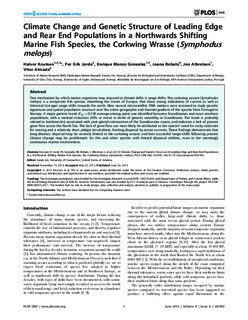| dc.contributor.author | Knutsen, Halvor | |
| dc.contributor.author | Jorde, Per Erik | |
| dc.contributor.author | Gonzalez, Enrique Blanco | |
| dc.contributor.author | Robalo, Joana | |
| dc.contributor.author | Albretsen, Jon | |
| dc.contributor.author | Almada, Vitor | |
| dc.date.accessioned | 2013-07-19T11:50:01Z | |
| dc.date.available | 2013-07-19T11:50:01Z | |
| dc.date.issued | 2013 | |
| dc.identifier.citation | Knutsen, H., Jorde, P.E., Gonzalez, E.B., Robalo, J., Albretsen, J., & Almada, V. (2013). Climate change and genetic structure of leading edge and rear end populations in a northwards shifting marine fish species, the corkwing wrasse Symphodus Melops. PLoS ONE, 8(6), e67492. doi: 10.1371/journal.pone.0067492 | no_NO |
| dc.identifier.uri | http://hdl.handle.net/11250/138273 | |
| dc.description | Published version of an article in the journal:PLoS ONE. Also available from the Public Library of Science: http://dx.doi.org/10.1371/journal.pone.0067492
Open Access | no_NO |
| dc.description.abstract | One mechanism by which marine organisms may respond to climate shifts is range shifts. The corkwing wrasse (Symphodus melops) is a temperate fish species, inhabiting the coasts of Europe, that show strong indications of current as well as historical (ice-age) range shifts towards the north. Nine neutral microsatellite DNA markers were screened to study genetic signatures and spatial population structure over the entire geographic and thermal gradient of the species from Portugal to Norway. A major genetic break (FST = 0.159 average among pairs) was identified between Scandinavian and more southern populations, with a marked reduction (30% or more) in levels of genetic variability in Scandinavia. The break is probably related to bottleneck(s) associated with post-glacial colonization of the Scandinavian coasts, and indicates a lack of present gene flow across the North Sea. The lack of gene flow can most likely be attributed to the species’ need for rocky substrate for nesting and a relatively short pelagic larval phase, limiting dispersal by ocean currents. These findings demonstrate that long-distance dispersal may be severely limited in the corkwing wrasse, and that successful range-shifts following present climate change may be problematic for this and other species with limited dispersal abilities, even in the seemingly continuous marine environment | no_NO |
| dc.language.iso | eng | no_NO |
| dc.publisher | PLOS | no_NO |
| dc.title | Climate change and genetic structure of leading edge and rear end populations in a northwards shifting marine fish species, the corkwing wrasse Symphodus Melops | no_NO |
| dc.type | Journal article | no_NO |
| dc.type | Peer reviewed | no_NO |
| dc.subject.nsi | VDP::Agriculture and fishery disciplines: 900::Fisheries science: 920 | no_NO |
| dc.subject.nsi | VDP::Mathematics and natural science: 400::Geosciences: 450::Meteorology: 453 | no_NO |
| dc.source.pagenumber | 11 p. | no_NO |
| dc.source.volume | 8 | no_NO |
| dc.source.journal | PLOS ONE | no_NO |
| dc.source.issue | 6 | no_NO |
